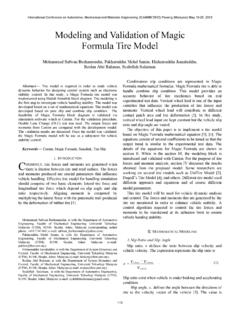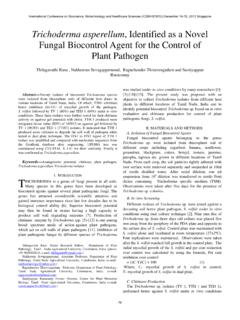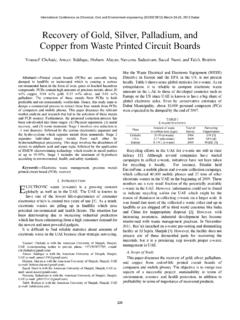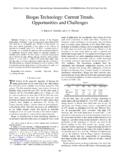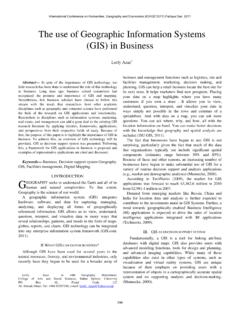Transcription of A Review of the Equations of State and their Applicability ...
1 Abstract This short paper reviews the Equations of State and their application to phase equilibrium modeling. The strengths, weaknesses and Applicability of these Equations will be assessed. Our intention is to test the Applicability of the Peng Robinson equation of State in the computation of thermodynamic interactions of volatile organic compounds and biodiesel. Thermodynamic models are very useful in phase equilibrium prediction as measurements are costly and time consuming.
2 Keywords Activity coefficients, Equations of State , modeling, phase equilibrium. I. INTRODUCTION A. Development of Equation of States N 1662, Robert Boyle found that the volume of a gas was inversely proportional to its pressure as shown in (1). constant=pV (1) Charles (1787) postulated that the volume of a gas was proportional to its temperature at isobaric conditions. In 1801, Dalton (1801) introduced the concept of partial pressures. Gay-Lussac (1802) defined the universal gas constant R.
3 Van der Waals (1873) s quantitative approach proposed the continuity of gases and liquids and provided the most important contribution to EOS development. In 1875 Gibbs made an important contribution to thermodynamics. In 1927, Ursell (1927) proposed a series solution (polynomial functional form) for the EOS known as the virial EOS (2)..+d+cb+1=P32 VVV+ (2) In 1949, Redlich & kwong introduced a temperature dependency to the attraction parameter a of the vdW EOS.
4 Pitzer (1955) introduced the acentric factor to quantify for S. Ramdharee is with the Department of Chemical Engineering, Faculty of Engineering and the Built Environment, University of Johannesburg, Doornfontein, Johannesburg 2028 (email; E. Muzenda is with the Department of Chemical Engineering, Faculty of Engineering and the Built Environment, University of Johannesburg, Doornfontein, Johannesburg 2028; phone: 0027-11-5596817; fax: 0027-11-5596430; e-mail: M. Belaid is with the Department of Chemical Engineering, Faculty of Engineering and the Built Environment, University of Johannesburg, Doornfontein, Johannesburg 2028 (e-mail: the non-sphericity of molecules and related it to vapor pressure data.))
5 In 1972, Soave modified the Redlich & kwong EOS by introducing Pitzer s acentric factor. Peng and Robinson (1976) proposed their EOS applicable to natural gas systems [1]. B. Definition of Equation State An Equation of State (EOS) is a semi-empirical functional relationship between pressure, volume and temperature of a pure substance. It is a thermodynamic equation describing the State of matter under a given set of physical conditions. Most EOSs are semi-empirical and are generally developed for pure substances. their application to mixtures requires an additional variable (composition) and hence an appropriate mixing rule.
6 The functional form of an EOS can be expressed as in (3). 0=) n1,=k,aT,V,f(P,pk (3) Ak and np are the parameters and categories of the Equations of State . np indicates the complexity of the EOS and the more complex is the equation, the more accurate it is. Currently, there is no single equation of State that accurately predicts the properties of all substances under all conditions [2]. Many cubic EOSs contain the original van der Waals repulsive term 2b)-(VRT The Peng Robinson and Soave-Redlich- kwong Equations of State are the most applicable in the petroleum industry [3].
7 The EOSs were developed to predict volumetric, thermophysical and vapour-liquid equilibrium data [3]. The main purpose for the development of the EOS approach was for generating of data which included volumetric, thermo physical data, and to help perform vapor/liquid equilibrium calculations. [3] Equations of State can be applied over wide range of temperature and pressure as well as to mixtures of diverse components, from light gases to heavy liquids. They can also be applied to supercritical phases without encountering any conceptual difficulties.
8 A Review of the Equations of State and their Applicability in Phase Equilibrium Modeling Sashay Ramdharee, Edison Muzenda and Mohamed Belaid I International Conference on Chemical and Environmental Engineering (ICCEE'2013) April 15-16, 2013 Johannesburg (South Africa)84II. Equations OF State A. Van der Waals Equation of State The van der Waals EOS (vdWEOS) is the basis of various EOSs. The contributions of the vdWEOS are that it laid foundations for modern cubic EOS, radically improved prediction potential, formulated the principle of corresponding states and was the first to predict continuity of matter between gas and liquid.
9 Van der Waals (1973) accounted for the non-zero molecular volume and non-zero force of attraction for a real substance. Van der Waals established that molecules should have an infinite volume and modified the pressure term of the Ideal gas equation to account for molecular interaction [4]. The prediction of liquid behavior became more accurate as the volume approaches a more limiting value, b at high pressures as in (4). b=V(p)limp (4) The vdW EOS gives a simple relationship between pressure, temperature and molar volume.
10 Considering the corrections to the ideal gas law, the Van der Waals equation of State is written as in (5). 2Va-b)-RT/(v=P (5) In (5) P, T, a, R and b are absolute pressure, molar volume, absolute temperature, attraction parameter, universal gas constant and the repulsion parameter. The van der Waals equation is not capable of predicting phase equilibrium accurately. B. Redlich kwong Equation The Redlich kwong is a cubic equation of State based on the van der Waals equation [5].

